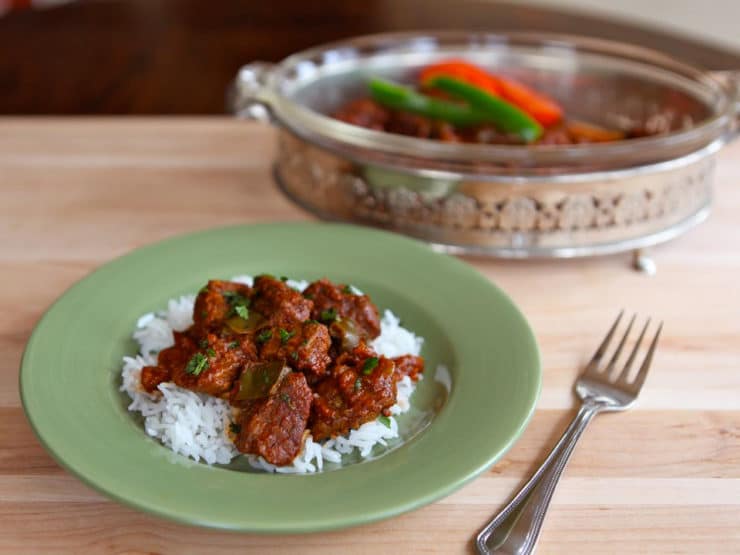
A few months ago, our friends Ron and Vanessa invited us over for dinner. Vanessa recently had twin girls – Carmel and Julia – aka the cutest little darlings in the history of children. I was really excited to spend some time with the babies (and Ron and Vanessa, of course!).
After dinner, Ron showed me a family recipe manuscript that his mother had given him. Ron’s family is Hungarian Jewish. When Ron started living on his own, his mom wrote down their family recipes so he could teach himself to cook the food he’d grown up with. He knew this manuscript would be right up my alley.
Traditional Hungarian Jewish recipes? I was thrilled! I took the manuscript home and scanned it, then began to study the dishes. It’s a colder than usual February here in Los Angeles, so a hearty beef stew called Marha Pörkölt seemed like the perfect dish to try.
Ron, Vanessa, and the twins
Marha Pörkölt translates from Hungarian to “Beef Stew.” What sets this dish apart from other beef stews is the paprika. Hungarian cooking is all about paprika; the spice is used liberally in many dishes. This particular paprika dish is quite common in Hungary. It originated with cattle herders, who made the dish in the fields in cast iron kettles and cooked it over an open fire. Marha Pörkölt is similar to another dish you may have heard of – goulash – which has the same origin and ingredients, though the texture of goulash would be slightly more soupy. You can actually make this recipe into a goulash by adding more liquid for a thinner sauce and adjusting the seasoning to taste.
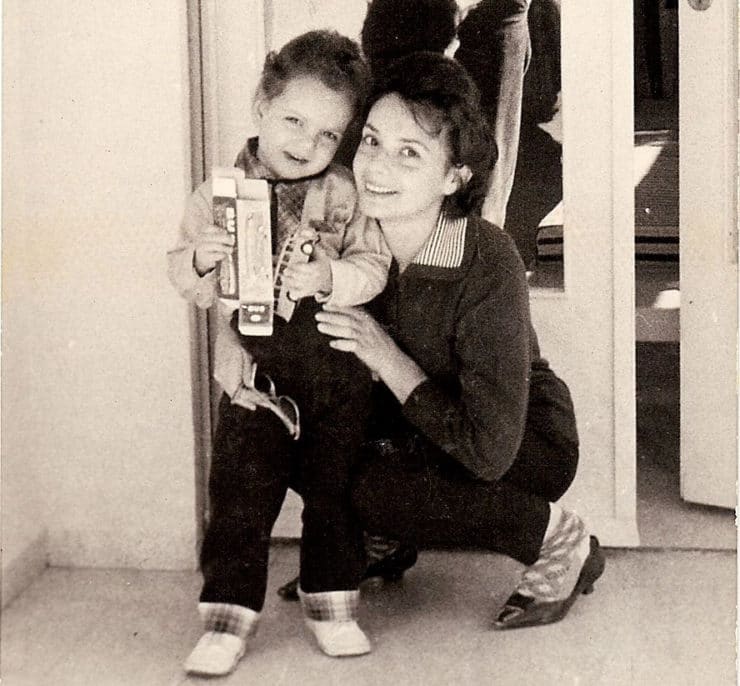
Ron and his mother Eva
I asked Ron to tell me a little about his family background, so we could understand exactly where this recipe came from. Ron’s family tree is pretty fascinating! Here are some of the highlights, in Ron’s words:
My mother was born Eva Neuwirth in Budapest, Hungary in 1929 to an affluent family. Her father Mihaly was a diplomat and in the import export business. Her mother Julia was of the famed Wertheimer family whose patriarch Samson Wertheimber, a wealthy banker, was given a rare title in the year 1510 by King Maximilian I, of the German Holy Roman Empire, for loans he provided the King. This bestowed family crest made the Wertheimbers “Koenigliche Yuden,” meaning “Noble Jews.” My mother, together with her sister Vera, were the embodiment of a happy pre-war Hungarian Jewish family. My father David Kenan was born Ivan Klein in Budapest Hungary in 1926 to Asher and Eta Klein. Eta is from the Schonberger family. Both families have numerous rabbis in their ancestry – the Kleins are Cohens.
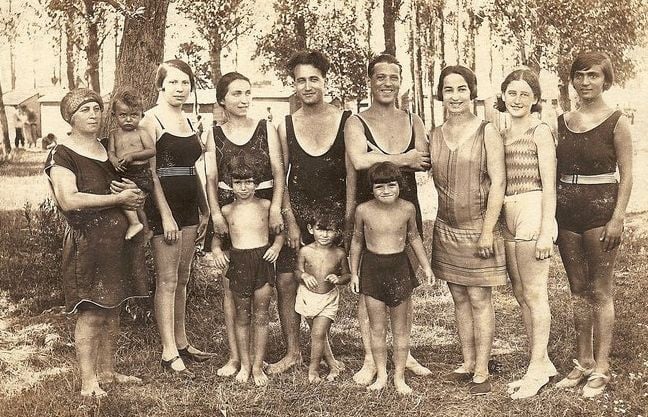
The Klein family, 1927. Ron’s great grandmother is holding his father on the left, and his grandparents are the third and fourth adults from the left.
Both of my parents are Holocaust survivors. My father escaped out of a Nazi labor camp, joined the partisans and made his way to Israel where he was in the Hagana and then had a long career in the Israeli Air Force. My mom survived the Nazis by hiding with false papers (she and her sister Vera had the same papers so they separated, one hiding in Buda and the other in Pest). She stayed in Budapest into the Communist era. There she married Dezso Steiner, the father of my brother Michael. After their divorce, she received permission to emigrate to Israel but when she got to the border, her name was crossed off the list and only her mother Julia, sister Vera, and son Michael were able to leave. She was left behind and couldn’t get out for several years until she escaped Hungary underground. This was extremely rare and dangerous. To this day she will not reveal the circumstances of her escape in order to protect a highly placed accomplice. She arrived in Israel where she met my father.

Ron as a baby in Israel
I was born in Tel-Aviv Yafo Israel in 1960, though we lived in Haifa most of my years there. My brother Michael, 12 years older, moved out of the house when I was 4. With my father generally in another city or country for military service and later his company, it was mostly me and mom and her cooking. In 1974 we moved to the US, 6 months in Columbus, OH, then 6 months in Bolivia where my father was working, and back to Columbus. Again in Columbus, it was me, my mom and her cooking.

Little Ron enjoying his Ima’s food
When I was 20 I joined a carnival to head out west to Los Angeles to pursue my music career. A few months before leaving, I had my mom write all of her recipes into an old Israeli school notebook (called a “machberet”). Every time she would make something, it had to go in the notebook. She adorned them with illustrations of steaming pans and pots to show the correct sized cookware. So cute! Fortunately, 20 years later, mom joined me in LA and the cooking celebration continued. To this day, she’ll grace my wife and I with an occasional fabulous creation of hers. Just this week she cooked her chicken liver recipe for our 1 year old twin girls Carmel (named after Carmel Mountain in Haifa where we lived) and Julia (after my grandmother). They liked it!
Of course they did! I’m not at all surprised. Little Carmel and Julia have very sophisticated taste. 🙂
Here is the original Marha Pörkölt recipe in Eva’s handwriting:
Click here to print the original recipe
I transcribed the recipe below, giving amounts and cooking times where needed. The original recipe said 1/4 green pepper and 1/4 tomato– I took that to mean a 1/4 lb. of each, since using only a quarter of a tomato and a quarter of a pepper wouldn’t add much flavor to the dish at all. 1 large tomato would be about 1/4 lb., and 1/2 a medium green bell pepper would be about the same. I used the remaining bell pepper and some sliced fresh tomato to garnish the stew. The resulting dish was tender and flavorful, the perfect dinner for a winter evening. This would be served over a traditional spaetzle or potatoes. Having neither on hand, I served it over rice and garnished it with parsley. It would also be great over egg noodles. It’s a pretty mild dish. For more heat, you could add a touch of spicy paprika or cayenne.
For some reason I can’t find the step-by-step photos I took of this recipe, but it’s pretty self explanatory– you shouldn’t have any problems. Next time I make it I’ll take pics and post them here.
Thank you to Ron Kenan, Eva Kenan and family for this wonderful taste of traditional Hungarian Jewish cooking!
Recommended Products:
We are a participant in the Amazon Services LLC Associates Program, an affiliate advertising program designed to provide a means for us to earn fees by linking to Amazon.com and affiliated sites. As an Amazon Associate I earn from qualifying purchases.
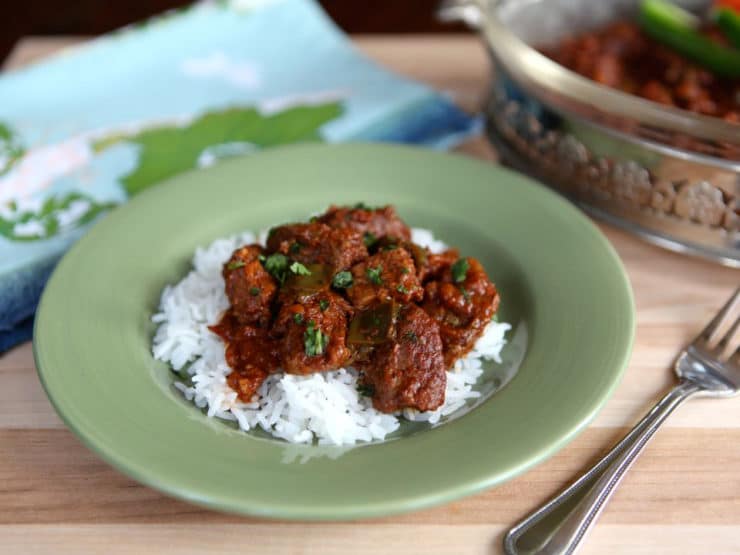
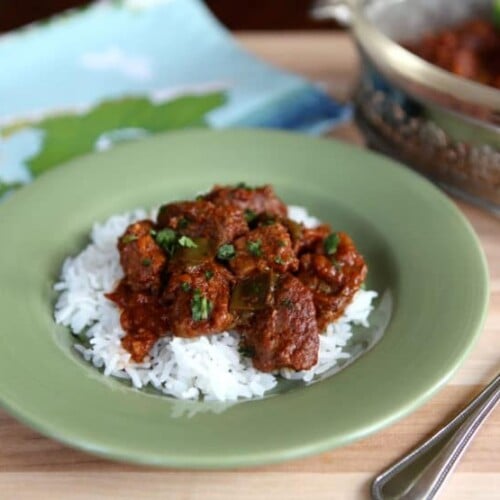
Marha Pörkölt - Hungarian Beef Paprika Stew
Ingredients
- 2 tablespoons vegetable oil (I used canola)
- 1 large onion, minced
- 1 large garlic clove, minced
- 1/2 medium green bell pepper, chopped
- 1 pound beef stew meat (I used lean beef)
- 2 tablespoons sweet (mild) paprika - Hungarian paprika is best
- 1 teaspoon caraway seeds
- 1 large tomato, cored and chopped
- Salt and black pepper to taste
- 1 tablespoon chopped fresh parsley for garnish (optional)
Instructions
- In a large saute pan, heat canola oil over medium. Add minced onion and saute for about 8 minutes till softened. Add the garlic and green bell pepper. Continue to saute for another 5 minutes till garlic is fragrant and bell pepper is tender-crisp.
- Add the beef to the pan and season lightly with salt and pepper. Cook for 5-6 more minutes, stirring twice, till meat is browned.
- Sprinkle paprika and caraway seeds evenly across the top of the meat. Add diced tomatoes to the pan. Pour 4-5 cups of hot water into the pan, till the meat is almost covered. Stir and bring to a boil.
- Reduce heat to a simmer and cover to pan. Let the mixture simmer slowly for about 90-100 minutes, replenishing the water as needed to keep it from getting dry.
- The stew is ready when the meat is fork tender and the sauce is thick. Season with additional salt and pepper to taste before serving, if desired.
- Serve over spaetzle, potatoes, rice or noodles. It would also be great over quinoa. Kosher for Ashkenazi Passover when served over a KFP starch (ex: potatoes). Garnish with chopped parsley, if desired. Enjoy!
Nutrition


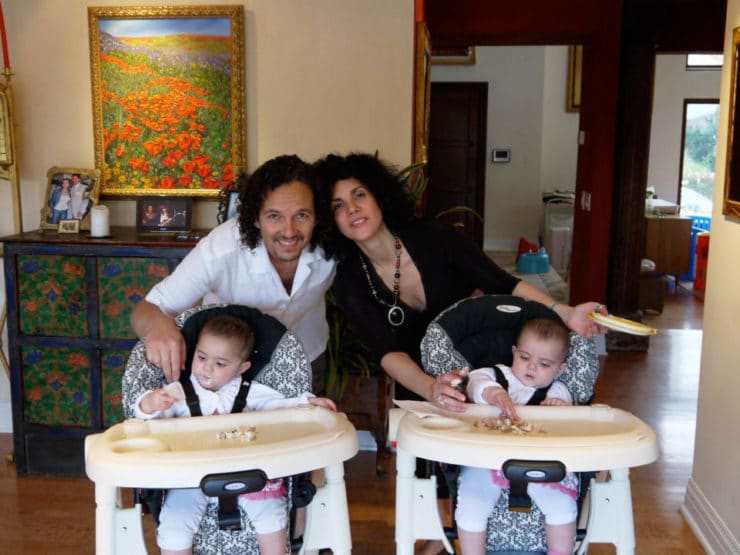
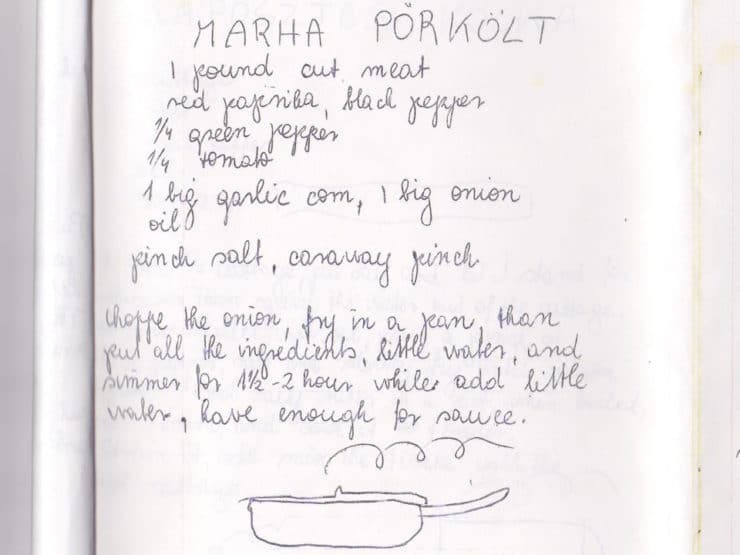


Please do not mix Jews Hungarian food with Hungarian food , because Jews food and Hungarian food is not same , even culture …….Hungarians is different than Jews even you look back in history.
My parents are also hungarian jews who I migrated in 70. The hungarian beef stew you posted is vety similar to my moms, who cooked 4 a living. We do not add a pepper though. Hungarian jews DO have family ways of cooking, and when you put the 2 together, it’s a Jewish hungarian style of cooking, that’s all!!!
I substituted the caraway seeds with cumin, and added a dry-roasted green chile for additional heat. I served it with boiled potatoes. Definitely a recipe to keep, thanks!
This was absolutely delicious! My second Tori Avey dish, with cumin instead of caraway seeds and added a skillet roasted green chile just for kicks. I’ll definitely be coming back for more, thanks.
This story is riveting. Thank you for sharing it with all of us. How wonderful for Ron to share it with you, and ultimately us, as well.
This recipe is fairly close to a traditional Hungarian paprikash. (My grandfather was an Hungarian Jew as well.) I would omit the caraway seeds. However, there is one basic ingredient your recipe lacks, which is also the main difference between a Jewish and a Hungarian recipe. Hungarians would add a few healthy dollaps of sour cream near the end of the cooking, and blend it in with the beef mixture. Orthodox Jews would never mix meat with dairy. If you don’t keep a kosher home, you might want to try it the original Hungarian way for a change.
Green bell peppers are often substituted in North America for the Hungarian pepper, which is a yellow version, more similar to the thinner fleshed Shepherd pepper than the bell pepper. It’s also used in Hungarian stuffed peppers. A totally different flavour as the green bell pepper is much stronger in flavour. If anyone has already suggested this in the past 2 years since the original post, kudos and apologies.
Thanks for the story. I am an American but moved to Hungary 16 years ago. I am not Jewish but I am still shocked about the Second World War and the legacy it still has. Great recipe, I am cooking done now with pork( mangolica from Hungary ). Thanks again!!
Kimball wiggins
I’m hungarian and like Marha pörkölt a lot. I can teach you another hungarian recipies if you want.
Do you have a recipe for Chicken Paprikas?
Kim here you go: https://toriavey.com/toris-kitchen/2013/10/kosher-chicken-paprikash/
thank you Boglarka …. 🙂 love you
Great story! My mother came to US when she was 16. She was from the village of Karcsa. We have been to Hungary 8 times. This is one of our favorite dishes. Thank you for sharing. FYI -I serve this dish by adding sour cream at the end. I serve it with rice or homemade crepes. Delicious!
Great story and lovely recipe…. Looking forward to trying it tonight! We are also parents of twin girls. Thank you for posting!
– kiwi family in Washington DC
nice
Since discovering this recipe earlier this year, I have made it multiple times, and I love it! Thank you for sharing this. It is delicious!!!
Best,
Christina @ http://thedancegrad.com
Classic Hungarian dish, love it. My dad just taught me how to make it. I love being Hungarian and what a cool story, something like my family’s
Absolutely fantastic recipe. Just like our grandma used to make. Served mine over mashed potatoes. Thank you for sharing the recipe and the story.
I made it tonight. excellent! thanks for sharing.
My mother made this and said to use about half the water… also to brown the meat in a separate pan before adding it to the main pot. I am making it now as per those directions and possibly also making some spaetzle. Thanks for sharing this, it’s new favorite in at least one household!
Hi! I found your blog searching for gluten-free recipes and just clicked this article. I am Hungarian as well, and this is indeed one of the most common dishes. Everyone has their own ‘secret’ as how to prepare it best 🙂 Some add cumin, others use vegetable broth instead of water, and you can eat it with basically any side dish.
Also, we make this with pork and even chicken, equally delicious. The combo of pepper, tomato and paprika is the key.
Barbara, the small dumplings are very easy to make, and the name is “nokedli”.
Try eating pickled cucumbers with it, that’s what we’d do 🙂
I found your site doing a google search for porkolt after a friend of mine came back from Budapest raving about it. I made your recipe last weekend while we had company staying with us. It was a big hit, it was served over wide noodles instead of rice. Next time I make this dish I will make my homemade spaetzle. Instead of making it in a large pot on the stove I browned all the meat, onions and garlic and used a crock pot on high for about 2 hours. Next time I’ll use a large pot and simmer it for an hour or so. I found lots of porkolt recipes online but what made yours stand out, aside from the fact that it didn’t call for lard, was the history you shared of your friend’s family. Thank you for sharing this and especially for the photos of him and his relatives. The history of this dish really brings it to life.
Thank you for the recipe! I’m looking forward to trying it. I particularly loved the story of your family and the photos. Thank you for sharing your family history. It is really special.
I’m trying to duplicate a dish I had in Budapest in May. The English name was Beef Paprikash. It was served with nukedli(sp?) which were small delicious dumplings. Traveled through Hungary and Romania and tasted fantastic food but this Beef Paprikash was the best. Can’t wait to try your recipe. I too found the amazing story of my Dad’s life and relatives I did not know I had in Romanian Transylvania that was part of Hungary until after WWI. It was a fairy tale journey. Thanks for the recipe!
The idea that this dish does not go with potatoes flies in the face of the fact that I grew up eating this on a regular basis, made by a gentleman chef from Budapest who escaped the Communist takeover in the 50’s. He served this over potatoes every time. This recipe is otherwise, the closest I’ve seen to his, great story & great recipe!
I agree, Joseph. I grew up in Hungary (countryside) and we always had pörkölt with cooked (cubed) potatoes, and chicken paprikás with dumplings. Hmmm, yum!
My parents were born in Hungary. Always had this with potatoes. mmmmmm!